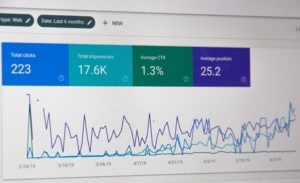Every non-profit wants to raise more money online. But most non-profits struggle to get traction raising money on their websites. One of the reasons why organizations struggle online is because they simply don’t have enough people visiting their websites… and if people aren’t visiting your website, they’re not going to donate on it.
In my experience, one of the best ways to get more people to visit your site… and to keep them coming back again and again… is to add a blog to your website. Adding a blog to your non- profit’s site is easy to do and will provide huge rewards to your organization down the line.
How is a Blog Different from a Website?
 The first question we need to answer is what we mean when we say “blog.” A blog is different from a simple, static website – or rather, it is an addition to your traditional non-profit website.
The first question we need to answer is what we mean when we say “blog.” A blog is different from a simple, static website – or rather, it is an addition to your traditional non-profit website.
Your non-profit does need a traditional website where people can learn more about your non-profit and your programs, connect with your staff, sign-up to volunteer, and donate to your organization. You need a good old-fashioned website with all of these things, the types of information that stays fairly constant. This part of your website will be updated, but not every day or every week… those pages will stay pretty static, with only periodic updates made to them.
Your non-profit’s blog is an add-on to your website. It is one section of your website where you are constantly adding new things. A blog is fluid and updated often. You can be a little less formal on your blog, and you should be adding new things at least once or twice per month, though adding new information weekly is a better goal.
How Can Adding a Blog Help Your Non-Profit?
I believe that every non-profit that has at least one full time fundraiser or one full time communications staff member should maintain an active blog on their website. There are 3 important ways that a blog can help your gain more traction with your website:
#1: A Blog Gives Your Supporters a Reason to Regularly Visit Your Website
If you want to grow traffic to your website, then your non-profit’s website needs to be more than just a brochure. Your goal as a non-profit fundraiser is to get your donors to see your website as a resource – a place they want to visit regularly for updates about your organization.
The only way your donors will want to visit your website often is if you are regularly updating your site, meaning that you are consistently posting new information that is interesting, informative, or entertaining. The single best way to do this is by having a regularly updated blog on your website, where you post something new each week. You can post an article, pictures, a video or any combination of the three, so long as you are doing it consistently.
Whatever is easiest and most appropriate for your non-profit.
#2: A Blog Provides SEO Power That Brings New Donors and Supporters to Your Website
 It’s not just your current donors and supporters that you are trying to attract to your website. You also want to make sure that new donors, new volunteers, new supporters, and others interested in your work can find your website and learn about your programs. A good way for new supporters to connect with you is by finding your website when they use a search engine like Google. One way to put your non-profit in a great position to get found in Google is by harnessing the power of SEO.
It’s not just your current donors and supporters that you are trying to attract to your website. You also want to make sure that new donors, new volunteers, new supporters, and others interested in your work can find your website and learn about your programs. A good way for new supporters to connect with you is by finding your website when they use a search engine like Google. One way to put your non-profit in a great position to get found in Google is by harnessing the power of SEO.
SEO stands for Search Engine Optimization. This is the process of putting content on your website in such a way so that when people search in Google for words and phrases related to your non-profit, Google gives them a link to your site. Search engine optimization also includes getting other websites to link to your site, so that Google and other search engines know that your content is worth sharing. One of the best ways to get people to link to your site is to post content that people want to share with others.
The process of search engine optimization is complex and beyond the scope of this article, but you should know that having a blog is helpful for SEO because you are posting lots of new content that can be found by search engines and that people might want to link to. This means that having a regularly updated blog will almost certainly increase traffic to your website. The increase won’t happen right away, but as you add new articles or other content every week or every other week, your traffic will slowly build. After a year of weekly blogging, you will likely see a significant jump in your web traffic year over year.
#3: A Blog Shows That Your Non-Profit is Active and Engaged
Having a regularly updated blog will show your donors, volunteers, and the community at large that your non-profit is active and engaged. When someone comes to your website, they will see that you posted a new informative article last week, or maybe the week before that. They will know that your non-profit is working hard and will be able to see what the latest news is from the frontlines of your programs. This will help support your fundraising efforts, your PR efforts, and your volunteer recruitment efforts.
What Type of Content Should You Put on Your Non-Profit’s Blog?
When planning out your blog content, it is important that you not overthink it. Don’t stress out about your blog content. Instead, commit to putting up either a short article of at least 300-400 words, or a short video of 1 minute or more, or some pictures with an explanation, and doing it each and every week. Consistency matters far more than perfection. Your posts can be informal so long as they are still professional, meaning no typos and no outrageous grammatical errors. But they don’t need to be perfect.
As for the exact types of content that you can create for your blog, you should be posting the same types of information you are putting in your newsletters, such as updates on your programs, updates on your events, profiles of your clients, staff, and donors, important updates on your mission field, etc.
In fact, many non-profits double dip with their content by posting blog articles and then using them as content in their newsletters… putting a summary of the article or the first paragraph of the article in their newsletter, with a link that says “Click here to read more.” This way, all of your e-mail newsletter subscribers will stay updated with what you are posting on your blog, and you don’t have to write twice as many articles by doing one for your blog and a separate one for your e-mail newsletter.
Adding a blog to your non-profit’s website will help you grow your website’s traffic, raise more money, and increase awareness of your organization. It’s easy and effective.
About the Author
 Joe Garecht is the President of Garecht Fundraising Associates. He has twenty years’ experience as a Development Director, Executive Director, and fundraising consultant to hundreds of non-profits.
Joe Garecht is the President of Garecht Fundraising Associates. He has twenty years’ experience as a Development Director, Executive Director, and fundraising consultant to hundreds of non-profits.






Every website should have a blog, but I see it being especially useful for nonprofit companies. These establishments should be able to bring in as many visitors as possible, in order to increase interest, and a blog with rich content can help.
Very informative article. I learned a lot of things from this blog. Thanks for sharing such a comprehensive article.
You’re so welcome. What was the best part?
This article was posted in 2020, and I am reading this towards the end of 2021, but it is still beneficial. I love how you analyze the advantages of a blog and what types of content a nonprofit can blog. I have had my website over a year ago. It has always been on my mind to start my blog. Also, I love how you gave the range of words to use in a blog. Thank you. Can you do something about a newsletter also?
Thanks for that! We do our best to bring you great ideas and solid info. We have several articles on newsletters. Start with this one: https://getfullyfunded.com/ultimate-nonprofit-email-newsletter/
I agree with the importance of blogs for non-profits. This was posted way back years ago, but it’s really beneficial. Only that, there are many updates with SEO if you will try to rank your site in search engines. Thank you.